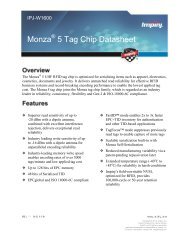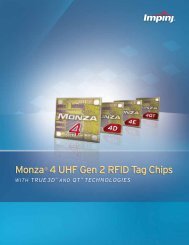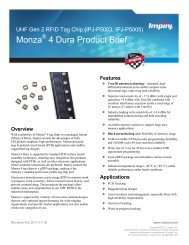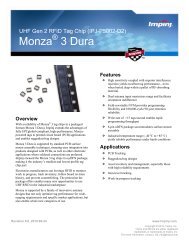Indy R1000 Datasheet - Impinj
Indy R1000 Datasheet - Impinj
Indy R1000 Datasheet - Impinj
Create successful ePaper yourself
Turn your PDF publications into a flip-book with our unique Google optimized e-Paper software.
<strong>Indy</strong> <strong>R1000</strong> ® Electrical, Mechanical, & Thermal Specification<br />
5.2.2 Digital Channel Filter<br />
The AC coupling after the mixer removes the major part of the DC; however, the DC content coming into the digital filter is for weak tag responses<br />
and still much larger than the amplitude modulation of the signal. To ensure robust preamble detection, the DC has to be reduced at the very<br />
beginning of the packet. The DC is estimated by a second order Butterworth IIR filter and subtracted from the output of the FIR filter. The group<br />
delay of the FIR filter is approximately the same as the low frequency group delay of the IIR DC estimation filter. This means that good DC<br />
suppression is possible at the very beginning of the preamble. During the last few bits of the packet, the output of the DC estimation filter must be<br />
held for optimum performance.<br />
Both the FIR and IIR filters are programmable with some limited restrictions. The FIR filter must be symmetric. It is not possible to shorten the<br />
group delay by setting the filter pre-cursor to zero, but it is possible to shorten the group delay by reducing the length of the filter. The signal input is<br />
injected into the first utilized filter tap. Therefore if the filter length is reduced, the data bypasses some data delay elements. The IIR filter<br />
coefficients must be normalized so that a0, b0, and b2 are all equal to one. Both the FIR and IIR coefficients must be real; i.e., it is not possible to<br />
distinguish between positive and negative frequencies in these filters.<br />
5.2.3 RSSI<br />
Received signal strength information is derived from amplitude information available in the phase recovery block. The information made available<br />
in the RSSI register is proportional to log 2 of the received signal amplitude. The information is averaged over a programmable number of samples<br />
as defined in register 0x281. The start time is defined in 0x280. The minimum specified level will be below the integrated noise floor for many IF<br />
filter bandwidth settings.<br />
5.3 Digital Transmitter Data Path<br />
The input to the TX data path is baseband encoded and shaped data from the controller for both the I and Q branches of the data path. For SSB, only<br />
the I output is used and the Q values are created by the Hilbert transformer. A frequency offset is added using a COordinate Rotation DIgital<br />
Computer (CORDIC) block to center the spectrum in the channel.<br />
In DSB operation, the DSB signal can be pre-distorted before being fed either through an upsampling or directly to the DAC. To allow for high<br />
bandwidth signals in C1G1, there is a bypass possibility at the DAC. This makes it possible to toggle the output of the DAC using a single bit.<br />
The output txpsk_phase, which is the sign bit of the DAC input, is provided for testing PR-ASK using polar modulation. The signal has a<br />
programmable delay to compensate for the delay in the reconstruction filter and other analog parts.<br />
18 Revision 2.3, Copyright © 2012, <strong>Impinj</strong>, Inc.







